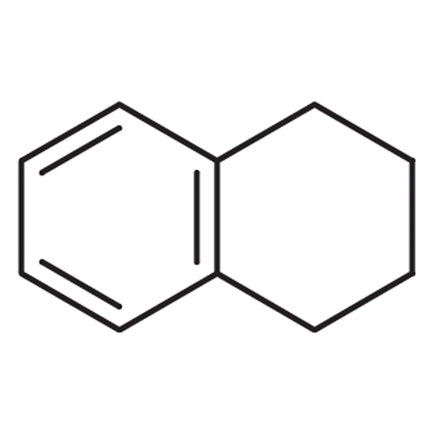Published TCIMAIL newest issue No.197
Maximum quantity allowed is 999
Please select the quantity
CAS RN: 119-64-2 | Product Number: T0107
1,2,3,4-Tetrahydronaphthalene

Purity: >97.0%(GC)
Synonyms:
Product Documents:
| Size | Unit Price | Belgium | Japan* | Quantity |
|---|---|---|---|---|
| 25ML |
£16.00
|
3 | ≥80 |
|
| 500ML |
£23.00
|
2 | ≥100 |
|
*Stock available in Belgium will be delivered in 1 to 3 days
*Stock available in Japan will be delivered in 1 to 2 weeks (excludes regulated items and dry ice shipments).
| Product Number | T0107 |
| Purity / Analysis Method | >97.0%(GC) |
| Molecular Formula / Molecular Weight | C__1__0H__1__2 = 132.21 |
| Physical State (20 deg.C) | Liquid |
| Storage Temperature | Room Temperature (Recommended in a cool and dark place, <15°C) |
| Store Under Inert Gas | Store under inert gas |
| Condition to Avoid | Air Sensitive |
| CAS RN | 119-64-2 |
| Reaxys Registry Number | 1446407 |
| PubChem Substance ID | 87576117 |
| SDBS (AIST Spectral DB) | 907 |
| Merck Index (14) | 9221 |
| MDL Number | MFCD00001733 |
Specifications
| Appearance | Colorless to Almost colorless clear liquid |
| Purity(GC) | min. 97.0 % |
Properties (reference)
| Melting Point | -36 °C |
| Boiling Point | 207 °C |
| Flash point | 75 °C |
| Specific Gravity (20/20) | 0.97 |
| Refractive Index | 1.54 |
| Solubility in water | Insoluble |
| Degree of solubility in water | 47 mg/l 28 °C |
| Solubility (miscible with) | Alcohol, Benzene, Ether |
GHS
| Pictogram |



|
| Signal Word | Danger |
| Hazard Statements | H302 : Harmful if swallowed. H315 : Causes skin irritation. H319 : Causes serious eye irritation. H373 : May cause damage to organs through prolonged or repeated exposure. H336 : May cause drowsiness or dizziness. H304 : May be fatal if swallowed and enters airways. H411 : Toxic to aquatic life with long lasting effects. |
| Precautionary Statements | P273 : Avoid release to the environment. P260 : Do not breathe mist or vapours. P264 : Wash skin thoroughly after handling. P391 : Collect spillage. P331 : Do NOT induce vomiting. P301 + P310 : IF SWALLOWED: Immediately call a POISON CENTER/doctor. |
Related Laws:
| EC Number | 204-340-2 |
| RTECS# | QK3850000 |
Transport Information:
| UN Number | UN3082 |
| Class | 9 |
| Packing Group | III |
| HS Number | 2902900000 |
Application
Preparation of Anhydrous Hydrogen Bromide

Typical procedure: Bromine is slowly added dropwise to a round bottom flask containing a suspension of iron and 1,2,3,4-tetrahydronaphthalene. In the early stage of the reaction, the flask is cooled with water. The reaction is warmed to 30 to 40 ℃ allowing gas evolution. The gas is passed through a wash bottle containing 1,2,3,4-tetrahydronaphthalene in order to eliminate any bromine in the hydrogen bromide. For optimum yields of hydrogen bromide, dry the 1,2,3,4-tetrahydronaphthalene over anhydrous sodium sulfate and then distill it under a dry inert atmosphere (such as argon or nitrogen). If any moisture is introduced into the reaction, the yield of hydrogen bromide becomes remarkably poor.
References
- Inorg. Synth. 1939, 1, 149.
PubMed Literature
Articles/Brochures
Product Documents (Note: Some products will not have analytical charts available.)
Safety Data Sheet (SDS)
Please select Language.
The requested SDS is not available.
Please Contact Us for more information.
Specifications
C of A & Other Certificates
Please enter Lot Number
Incorrect Lot Number. Please input only the 4-5 alphanumeric characters before the hyphen.
Sample C of A
This is a sample C of A and may not represent a recently manufactured lot of the product.
A sample C of A for this product is not available at this time.
Analytical Charts
Please enter Lot Number
Incorrect Lot Number. Please input only the 4-5 alphanumeric characters before the hyphen.
The requested analytical chart is not available. Sorry for the inconvenience.






![1,2,3,4-Tetrahydronaphthalene [for Spectrophotometry] 1,2,3,4-Tetrahydronaphthalene [for Spectrophotometry]](/medias/T0713.jpg?context=bWFzdGVyfHJvb3R8MzM3NTl8aW1hZ2UvanBlZ3xhR0U1TDJobFppODRPVE15TXpZM09USTFNamM0TDFRd056RXpMbXB3Wnd8ZTlkM2E4ZWFhOTAwNzNjN2E0ZjQwNjFjYmE4MzZkNTI0NTNjZWE3ZDNmMTY4MDNlNGQxYWE2MjRhMWYyODE1Nw)